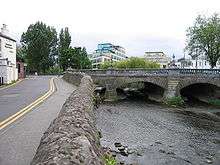Henry Barry, 4th Baron Barry of Santry
Henry Barry, 4th Baron Barry of Santry (1710-1751), often referred to simply as Lord Santry, was an Irish peer. He is unique in being the only Irish nobleman to be convicted of murder by his peers and sentenced to death. He later received a full pardon.
Biography
He was born in Dublin on 3 September 1710, only son of Henry Barry, 3rd Baron Barry of Santry, and Bridget Domvile, daughter of Sir Thomas Domvile, 1st Baronet, of Templeogue.[1] He succeeded to the title in 1735. He married firstly Anne Thornton of Finglas, who died in 1742, and secondly Elizabeth Shore of Nottingham, but had no issue by either marriage. He died in Nottingham on 22 March 1751 and was buried at St. Nicholas' Church, Nottingham.[2]
Murder of Laughlin Murphy
Santry seems to have been the typical eighteenth-century rake, with a quarrelsome, drunken and violent nature: it is significant that he was a member of the notorious Hellfire Club.[3] On 9 August 1738 he was drinking with some friends at a tavern in Palmerstown, which was then a small village near Dublin city. Santry, who had drunk even more heavily than usual, attacked a Mr Humphries, but was unable to draw his sword. Enraged, he ran to the kitchen, where he chanced to meet Laughlin Murphy, the tavern porter, and without any reason ran him through with his sword.[4] Having bribed the landlord, he made his escape. Murphy was taken to Dublin where he lingered for some weeks; he died on 25 September 1738.[5]
Trial
Although Lord Santry was not immediately apprehended, there is no reason to think that the Crown intended that he should escape justice; indeed the authorities clearly aimed not only to prosecute him but to secure a conviction. Even in an age when the aristocracy enjoyed special privileges, the murder of Murphy, who by all accounts was an honest and hardworking man with a wife and young family to support, had shocked public opinion. In due course Santry was arrested and indicted: he demanded, as the privilege of peerage, a trial by his peers. The trial, which took place in the Irish Houses of Parliament on 27 April 1739, aroused immense public interest.[6]
Lord Wyndham presided in his role as Lord High Steward of Ireland, with 23 peers sitting as judges. The Attorney-General for Ireland, Robert Jocelyn and the Solicitor-General for Ireland, John Bowes, led for the prosecution.
Bowes dominated the proceedings and his speeches made his reputation as an orator. Thomas Rundle, Bishop of Derry, who as a spiritual peer was only an observer at the trial[7] said "I never heard, never read so perfect a piece of eloquence...the strength and light of his reason, the fairness and candour".[8] The Bishop was scathing about counsel for the defence, describing Santry's counsel as "detestable".[9] The defence case was that Murphy had died not from his wound but from a long-standing illness, but in view of the medical evidence produced by Bowes this was a hopeless argument; according to Bishop Rundle, Santry's counsel failed even to mention the possibility that Murphy, who lingered for 6 weeks, might have died through inadequate medical care. Given the overwhelming evidence, any defence was probably useless, and despite what was described as their "looks of horror", his peers had little difficulty in finding Santry guilty. Wyndham, who had conducted the trial with exemplary fairness, pronounced the death sentence.[10]
Aftermath
King George II had the prerogative of mercy, and accordingly a campaign was launched by Santry's friends and relatives to persuade the King to grant a pardon. Their plea seems to have concentrated on the victim's low social standing, the implication being that the life of a peer was worth more than that of a tavern worker, despite the victim's blameless character, and the savage and wanton nature of the murder. The King proved reluctant to grant a pardon,[11] and for a time it seemed that Santry must die, but in due course a reprieve was issued. Popular legend had it that his uncle Sir Compton Domvile, through whose estate at Templeogue the River Dodder flowed, secured a royal pardon for his nephew by threatening to divert the course of the river, thus depriving the citizens of Dublin of their main supply of drinking water.[12]

On 17 June 1740, Lord Santry received a full royal pardon and the restoration of his title and estates; soon afterwards he left Ireland for good. On his death in 1751 the title became extinct; his estates passed to his Domvile cousins.
Parallel cases
In 1628 Lord Dunboyne was tried by his peers for manslaughter but acquitted. In 1743 Nicholas Netterville, 5th Viscount Netterville was acquitted of murder by his peers, as was Lord Lorton in 1798.[13]
References
- ↑ Cokayne, G. E. Complete Peerage Reprinted Gloucester 2000 Vol.1, p. 448
- ↑ Cokayne p. 448
- ↑ O'Flanagan, J. Roderick The Irish Bar Sampson Low, Marston, Searle and Rivington London 1879 p.7
- ↑ O'Flanagan p.8
- ↑ O'Flanagan p.8
- ↑ O'Flanagan p.9
- ↑ By a long-standing tradition spiritual peers did not vote in criminal cases.
- ↑ Ball, F. Elrington The Judges in Ireland 1221-1921 London John Murray 1926 Vol.2 pp.133-4
- ↑ O'Flanagan p.12
- ↑ O'Flanagan p.12
- ↑ Horace Walpole wrote that King George II, though merciful enough in other cases involving the death penalty, rarely pardoned a murderer.
- ↑ O'Flanagan p.13
- ↑ O'Flanagan pp.14-15